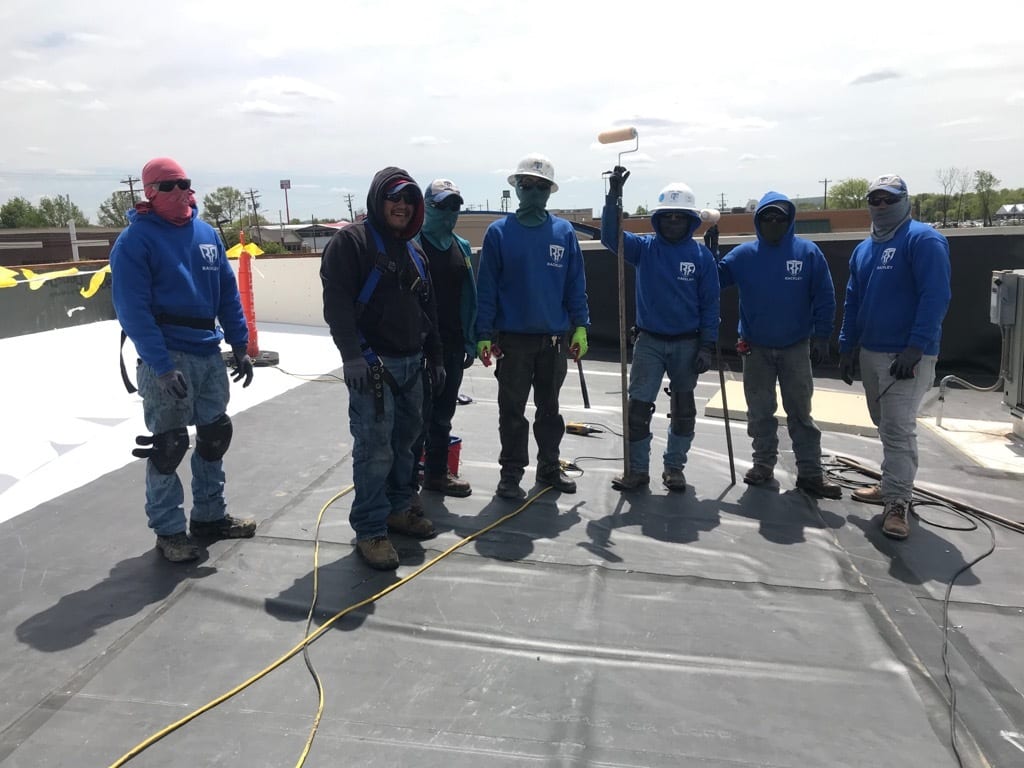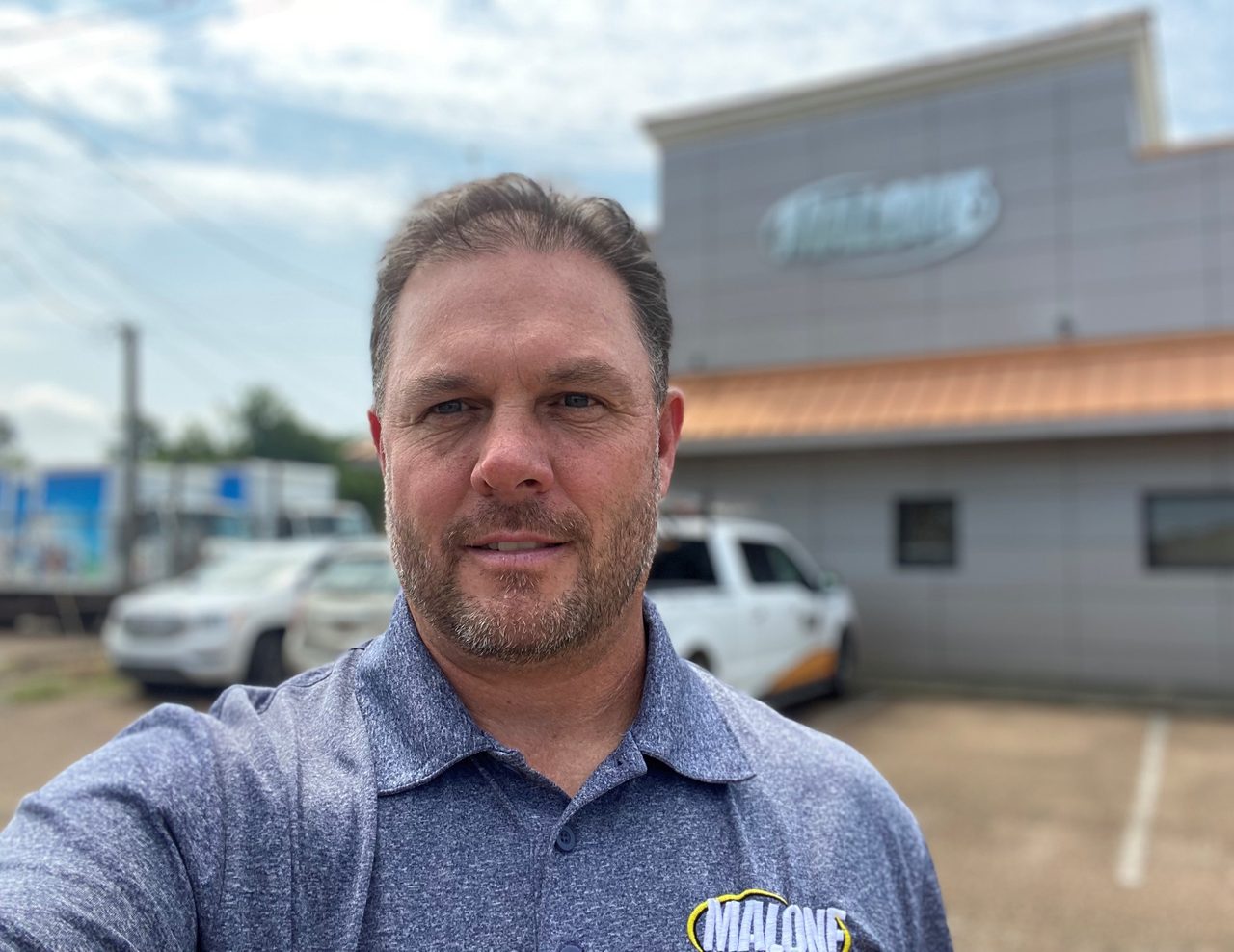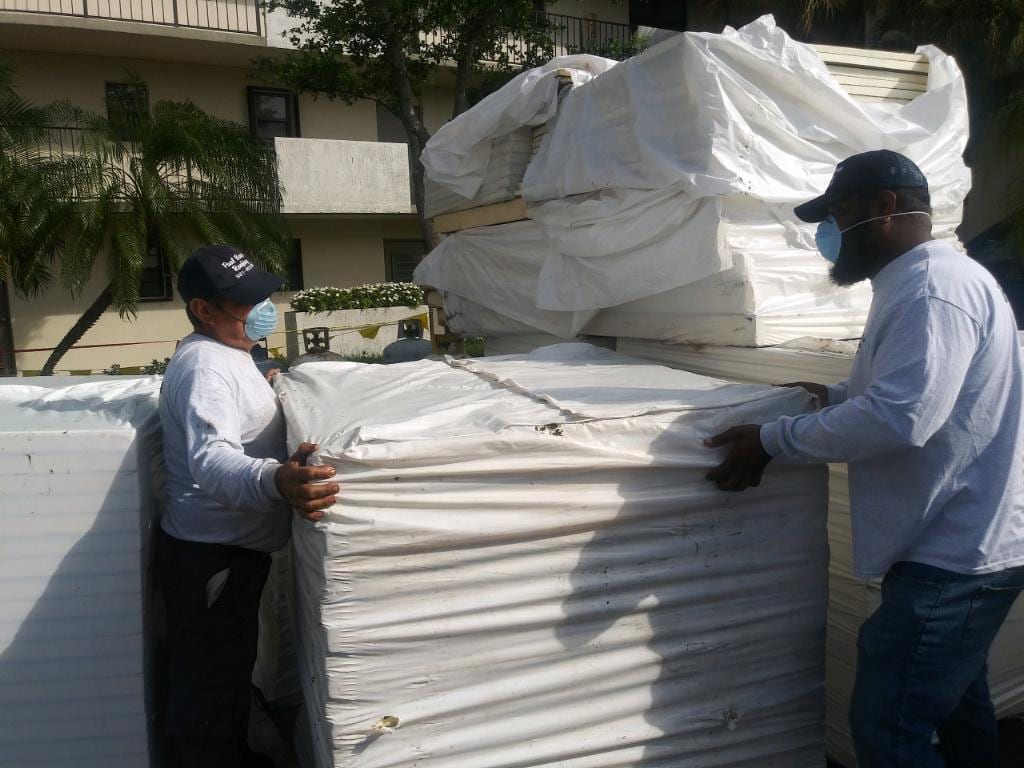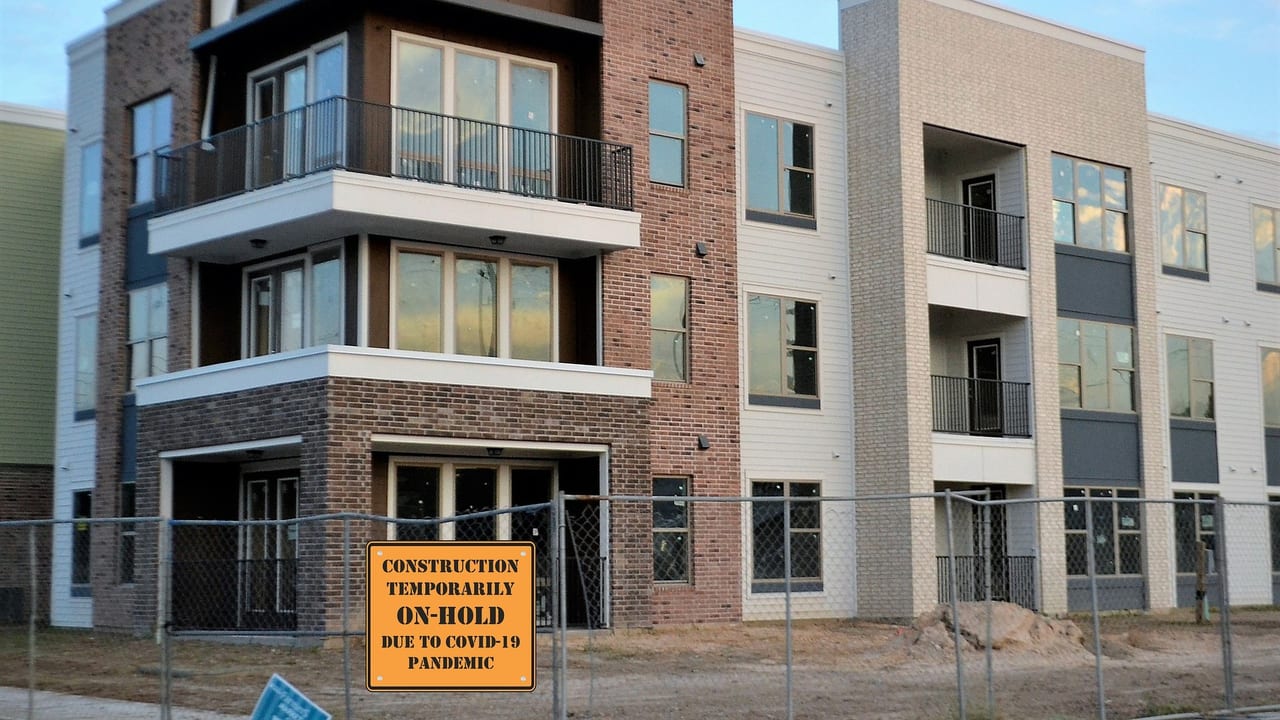
Workers from Rackley Roofing in Tennessee staying safe during the COVID pandemic. Photo courtesy of Rackley Roofing Company.
BY ART AISNER
Leaders of elite roofing companies lean on each other to navigate material shortages and an uneasy economy
Roman Malone paused for a moment, sorted through the images racing through his head over what his veteran roofing company endured over the past 18 months, and didn’t hold back.
“2020 was a wild ride for us, like I think it was for most everybody,” the president of Malone Roofing Services said. “It started off really hot and then in March and April it just went dead. The bottom dropped out for us.”
Malone said the company lost 20% of its revenue generated in reroofing contracts in 30 days, across eight branches stretching from the Mississippi Delta to the Florida Panhandle and north into Tennessee. He called the experience “pretty humbling,” while giving his blunt assessment to a trusted peer group of other roofing company leaders during a video chat organized by RC.
Malone said he understood that many of the company’s high-end commercial roofing customers had their own challenges during the pandemic — including fluctuating stock valuations and corporate strategy changes brought about by the pandemic. It was harder to tell that to 250 employees eager to get back to work, even with more stringent health and safety protocols forced upon them.
Generally an optimist, Malone said it was difficult not to get discouraged by the uncertainty. Two things helped get him through — a record hurricane season by year’s end that helped recoup some of the losses spurred by the pandemic, and his peer group. He may only be able to depend on one of those factors this year, given recent challenges roofers are having finding supplies.
“We’ve got to plan out six months for our reroof or new construction program. You might be able to get membrane in six weeks or you might be able to get adhesives in 12 weeks, but you can’t get fasteners. And you can’t get ISO, so it’s a huge impact.”
— Steve Little
“2020 was a wild ride for us, like I think it was for most everybody. It started off really hot and then March and April hit and it just went dead for us. Now, like everyone else, we’re having trouble finding materials and keeping that work going, so the future is a little uncertain for us.”
— Roman Malone


Punishing Prices
Steve Little knows that pain point all too well. While COVID-19 shutdowns devastated the hospitality and transportation industries nationwide, construction — and roofing in particular — was largely spared an immediate impact. The 400-plus employees at Dallas-based KPost Roofing & Waterproofing churned away at a strong company backlog at the onset of COVID-19 lockdowns.
Deemed essential early on and able to get back to work, the company had a record year in terms of projects. Ironically, Little said, KPost’s once-booming maintenance business dried up, with a 25% reduction in business year-over-year as commercial clients closed their buildings and refocused capital funds to upgrade ventilation systems, improve social distancing and enhance technology.
Momentum was strong in Q1 of this year, but then the paperwork started showing up. A flurry of emails, followed by letters, and even a reluctant phone call or two all indicated prices were going up, and ordered materials were on standby. By July, Little compiled 37 different letters and pricing bulletins from various industry manufacturers related to consistent increases and freight shipping woes.
He put together a presentation with a timeline to share with clients so that they could grasp the urgency and reality that projects wouldn’t be completed on time.
“This was really unheard of,” he said. “You might be able to get membrane in six weeks or you might be able to get adhesives in 12 weeks, but you can’t get fasteners. And you can’t get ISO, so it’s a huge impact.
“We showed them the timelines, and ironically, when we got out there we realized the bricklayers didn’t have bricks, the plumbers didn’t have piping and the electricians didn’t have conduit.”
It wasn’t happening just in the Dallas market.
An analysis of data from the U.S. Bureau of Labor Statistics by the Associated Builders and Contractors found non-residential construction material prices rose nationwide by nearly a full percentage point from June to July, and increased more than 23% compared with 2020. After a month-to-month drop in July, lumber prices are up 45% year-over-year, and iron and steel prices are up 89% in that same span.
As his litany of letters explained, Little saw what began as a raw materials issue caused by global COVID-19 lockdowns and the Texas deep freeze, shift into a transportation crisis and then evolve into a deep shortage fueled by global demand. A bit bewildered, he asked his peers if they were getting the same explanations.

Roofing materials have been hard to come by for contractors across the country, regardless of whether in residential or commercial markets. The shortage is causing a new layer of challenges for roofers trying to emerge from 2020. Photo courtesy of Paul Bange Roofing.
“We flat out can’t get materials, and we’re losing good people. That’s the scary part. We’ve looked at changing (roofing) systems, and brainstorming as best we could before we really got wind of the problem. You can play games with every system out there, but at the end of the day, if they’re not tested they’re probably not going to get installed. It’s created a big logjam.”
— Brad Beldon
“We’re really finding out what loyalty is between the contractor and the manufacturer, and that can be frightening. When you would think that after 20 years of giving certain companies the vast percentage of your business, and then still having to wait for materials, you start to wonder what your position really is and what that relationship really is long-term. That’s been an eye opener.”
— Kayhan Fatemi


Workforce Woes Worsen
Indeed, peers like Kayhan Fatemi and Sean Taba of BEST Contracting Services in Gardena, Calif., confirmed these issues were not isolated. The supply shortages were equally impacting their operations as a union contractor, and it was also having an impact on staffing projects. When BEST needs people, they contact the union hall and get the process going. When jobs stall or can’t be completed due to a materials issue, those workers are placed back in the workforce “marketplace.”
“The danger for contractors like us in that situation is that when you send them back to the hall, your competitors pick them up for projects, and you lose good hands,” Fatemi explained.
That didn’t prevent BEST from completing some of the major public works and stadium projects that helped propel them to number six on RC’s 2021 Top 100 list with a reported $166 million in revenue. But BEST has gotten creative using incentives like extra pay or added hours to keep their employees’ interest. He shared that the material shortage is toughest on the waterproofing side of the business, where they are entirely reliant on the right materials.
“Without them we’re at a standstill on those jobs. The guys cannot work without the material,” he said. “It’s scary, because these are all good guys that we don’t want to lose.”
Shedding people was also at the top of Brad Beldon’s concerns when assessing the current state of roofing. As chief culture officer for Beldon Roofing Company, the fourth-generation roofing company based in San Antonio, Texas, he’s witnessed the industry’s workforce problem take a major turn for the worse.
“We flat out can’t get materials, and we’re losing good people. That’s the scary part,” he said. “We’ve looked at changing (roofing) systems, and brainstorming as best we could before we really got wind of the (supply) problem. You can play games with every system out there, but at the end of the day, if they’re not tested they’re probably not going to get installed. It’s created a big logjam.”
Unfortunately, the outlook isn’t that great either, the contractors lamented. Best estimates for the situation to normalize are looking well into 2022, which means more time for strained relationships with suppliers to fray further.
“We’re really finding out what loyalty is between the contractor and the manufacturer, and that can be frightening,” Beldon said. “When you would think that after 20 years of giving certain companies the vast percentage of your business, and then still having to wait for materials, you start to wonder what your position really is and what that relationship really is long-term. That’s been an eye opener.”
Peer Power
The impact of having a group of like-minded colleagues with varied experiences was also a big realization through the back-to-back crises. This particular group also includes Matt Brown, president at Atlas Roofing and Coating Systems in Des Moines, Iowa; and Curtis Sutton, president of Rackley Roofing in Nashville, Tenn. They have meetings a few times a year facilitated by Greg Hayne of the Hayne Coaching Group and talk regularly about industry-related topics, and beyond.
“The beauty of the peer group is that ability to bounce questions off others, as true peers, and invariably, no matter what the issue, someone has experienced it or something like it and has stories to share with first-hand knowledge. That really has been helpful,” Fatemi said.
Peer groups are not new to the roofing space, but more leaders are seeing the return on investment. Beldon said the frank discussions with like-minded colleagues from different markets has helped push them through the challenging times. The value and need crystallized during the pandemic and continue on as the economic recovery continues.
“It’s a dialogue where you know you don’t have to worry about hurting anyone’s feelings, and what you want is good, honest feedback. And it’s invaluable,” Beldon said. “We all know where we’re coming from and we all have each other’s back.”
With uncertainty still lingering in the new future, Malone said he’s ready to lean on his peers even more as another busy hurricane season approaches.
“In this group, everyone’s seen something different than the other, and we can all learn something from each other. For me it’s just been really beneficial,” he said. “I couldn’t imagine if a hurricane hit with this material situation the way that it is, with everyone going after the same materials. I don’t have a good answer for that one.”
But he’s got a strong group of friends now to help him figure that out.

Health and safety fears forced numerous jobsite delays or flat-out cancellations for construction in the early days of the COVID-19 pandemic. While jobs have returned, roofing companies are now dealing with a shortage of supplies to complete them, adding a lot of uncertainty to the industry’s outlook.
Art Aisner is editor of Roofing Contractor. Reach him at 248-244-6497 or aisnera@bnpmedia.com.